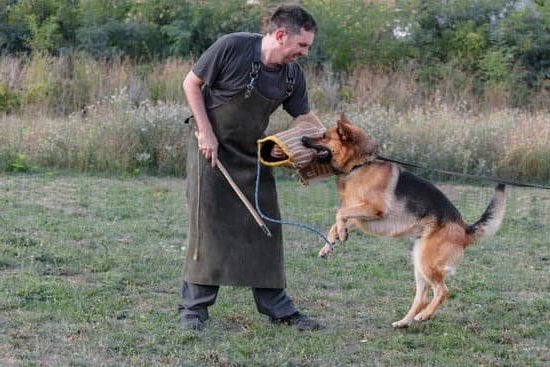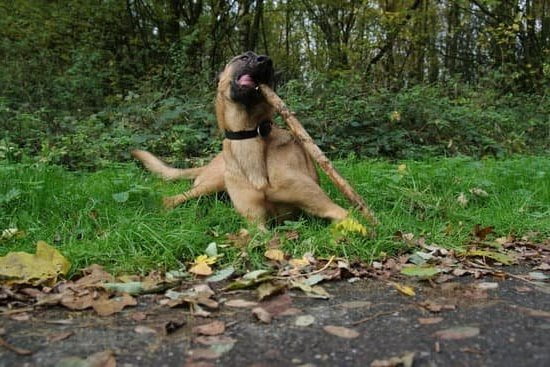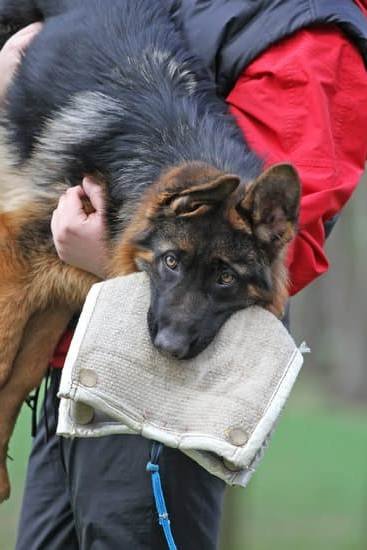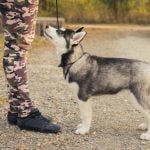Food aggression in dogs can be a challenging behavior to address, but with the right approach and understanding, it is possible to overcome. In this article, we will delve into how to train a dog with food aggression. Understanding the causes and identifying the signs of food aggression is crucial in developing an effective training plan.
Dogs may exhibit food aggression due to various reasons such as resource guarding, fear, or anxiety. It is essential for pet owners to recognize the warning signs which may include growling, snapping, or even biting when approached while eating. Seeking professional help from a trainer or behaviorist can provide valuable guidance in dealing with this issue and creating a safe environment for both the dog and its caregivers.
Creating a positive and stress-free space for training is key in addressing food aggression. Desensitization techniques, gradual exposure to food, and counterconditioning are effective ways to modify your dog’s behavior around meal times.
Positive reinforcement training using treats to reward good behavior can also help in reshaping your pet’s response to feeding activities. By implementing consistent rules and boundaries, along with establishing a routine for feeding and training, pet owners can effectively manage food aggression in their dogs.
The Importance of Seeking Professional Help
Food aggression in dogs can be a serious issue that requires professional help to address effectively. If your dog displays signs of food aggression such as growling, snapping, or guarding their food aggressively, it is important to seek the guidance of a qualified trainer or behaviorist. These professionals are experienced in dealing with behavior problems in dogs and can provide you with the necessary tools and techniques to help your furry friend overcome their food-related issues.
When deciding whether to consult a trainer or behaviorist for help with food aggression, consider the severity of your dog’s behavior and your own level of comfort and expertise in addressing the issue. While some mild cases of food aggression can be managed through training and behavior modification techniques at home, more severe cases may require the expertise of a professional.
A trainer or behaviorist can assess your dog’s behavior, develop a customized training plan, and guide you through the process of desensitizing your dog to food-related triggers.
To find a reputable trainer or behaviorist who specializes in dealing with food aggression in dogs, consider asking for recommendations from your veterinarian or local animal shelter. Look for professionals who use positive reinforcement methods and have experience working with similar behavioral issues. By seeking professional help early on, you can address your dog’s food aggression effectively and prevent any potential escalation of aggressive behaviors in the future.
- Assess the severity of your dog’s food aggression behavior
- Seek recommendations from trusted sources for a qualified trainer or behaviorist
- Choose a professional who uses positive reinforcement methods and has experience with similar behavioral issues
Setting the Right Environment for Training
Food aggression in dogs can be a concerning behavior that pet owners may encounter. It is essential to understand the root causes of food aggression to address it effectively. Dogs may display this behavior due to fear, resource guarding, or past experiences of scarcity. Recognizing the signs of food aggression, such as growling, snapping, or guarding their food bowl, is crucial in identifying this issue in your dog.
One effective way to train a dog with food aggression is by creating a safe and positive training environment. This includes establishing a designated feeding area for your dog where they can eat without feeling threatened or anxious. Avoid approaching your dog while they are eating to prevent triggering any aggressive reactions. Additionally, ensure that your dog has a comfortable space where they can eat without disturbances from other pets or family members.
To address food aggression in dogs, implementing desensitization techniques can be beneficial. Gradual exposure to food and counterconditioning methods can help your dog associate positive experiences with mealtime. This involves slowly introducing stimuli that trigger aggressive behavior while rewarding calm and non-aggressive responses. By consistently practicing these techniques and using positive reinforcement, you can help your dog learn new behaviors and overcome food aggression issues.
| Desensitization Techniques | Creating a Safe Environment |
|---|---|
| Gradual exposure to triggers | Establishing a designated feeding area |
| Counterconditioning methods | Avoiding disturbances during mealtime |
Desensitization Techniques
Food aggression in dogs can be a serious behavioral issue that requires proper training and management. Desensitization techniques, along with counterconditioning, can be effective methods to address this problem. By gradually exposing the dog to food-related triggers and changing their response through positive reinforcement, it is possible to help them overcome their aggressive behaviors.
Gradual Exposure to Food Triggers
One of the key components of desensitization techniques is gradual exposure to the trigger that causes the aggressive behavior, in this case, food. This means slowly introducing the dog to situations where they may exhibit signs of aggression, such as when someone approaches their food bowl. By starting at a distance and gradually decreasing it over time while monitoring the dog’s reaction, you can help them learn to remain calm and relaxed during feeding times.
Counterconditioning Through Positive Reinforcement
Counterconditioning involves changing the dog’s response to the trigger from a negative one (aggression) to a positive one (calmness). This is often done through the use of treats or rewards whenever the dog displays non-aggressive behavior around food.
For example, if the dog allows someone to approach their food bowl without showing signs of aggression, they should be rewarded with a high-value treat. Over time, the dog will associate positive outcomes with calm behavior around food, effectively addressing their food aggression issues.
Training a dog with food aggression can be challenging, but with patience and consistency in applying desensitization techniques and counterconditioning methods, it is possible to help your furry friend overcome their aggressive behaviors and create a safe feeding environment for both them and those around them. Remember that seeking professional help from a trainer or behaviorist may also be beneficial in some cases, especially if the aggression is severe or persistent despite your efforts at home.
Positive Reinforcement Training
Food aggression in dogs can be a concerning behavior that requires careful management and training. Positive reinforcement training is a highly effective method for addressing this issue by using treats to reward good behavior and discourage aggression. This approach focuses on reinforcing desired behaviors while avoiding punishment, creating a more positive learning experience for your dog.
When implementing positive reinforcement training to address food aggression, it is essential to start with small steps and gradually work towards the desired behavior. Begin by rewarding any calm and non-aggressive behavior around food, such as sitting quietly or waiting patiently. As your dog begins to associate this behavior with receiving treats, you can then move on to addressing more specific instances of food aggression.
One effective technique is to practice “trading up,” where you offer your dog a high-value treat in exchange for giving up a lower-value item they may be guarding. This helps teach your dog that giving up something does not mean losing out entirely, but rather gaining something even better in return.
Consistency and patience are key when using positive reinforcement training to address food aggression, as it may take time for your dog to unlearn their previous behaviors. By remaining consistent and rewarding good behavior, you can help your dog overcome food aggression in a positive and rewarding way.
| Positive Reinforcement Training | Addressing Food Aggression |
|---|---|
| Start with small steps | Reward any calm behavior around food |
| Practice “trading up” | Offer high-value treat in exchange for lower-value item |
| Consistency and patience are key | Reward good behavior consistently |
Implementing Consistent Rules and Boundaries
Food aggression in dogs can be a concerning behavior that may pose risks to both the dog and its owners. One of the key aspects in addressing this issue is implementing consistent rules and boundaries to establish a routine for feeding and training. By creating a structured environment, pet parents can help their dogs develop positive behaviors around food and prevent aggressive tendencies during meal times.
Establishing a Feeding Schedule
One of the first steps in establishing consistent rules for a dog with food aggression is to create a regular feeding schedule. By feeding your dog at the same times each day, you can help them anticipate meal times and reduce anxiety or frustration that may trigger aggressive behavior. Make sure to also feed your dog in a quiet and calm environment to promote relaxation during meals.
Implementing Basic Obedience Training
Training your dog in basic obedience commands such as “sit,” “stay,” and “leave it” can be incredibly helpful in managing food aggression. These commands not only improve your communication with your pet but also give you tools to redirect their attention or behavior if they show signs of aggression during feeding time. Consistent training sessions will reinforce good behavior and build trust between you and your furry companion.
Creating a Positive Feeding Routine
In addition to scheduling meals and practicing obedience training, it’s essential to establish a positive feeding routine for your dog with food aggression. Use feeding time as an opportunity to bond with your pet by hand-feeding them or incorporating interactive puzzle toys that dispense treats.
This not only makes meal times more enjoyable but also helps create positive associations with food, reducing the likelihood of aggressive behavior. Remember, patience, consistency, and positive reinforcement are key when training a dog with food aggression.
Techniques for Managing Food Aggression During Meal Times
Food aggression during meal times can be a concerning behavior in dogs that often stems from various underlying reasons such as fear, anxiety, resource guarding, or past experiences. It is crucial to address this behavior promptly and effectively to ensure the safety of both your dog and those around them. Here are some techniques for managing food aggression during meal times:
- Practice Feeding Separately: If you have multiple dogs in your household, consider feeding them in separate areas to prevent competition and potential conflicts over food.
- Use Slow Feeder Bowls: Slow feeder bowls can help regulate the speed at which your dog eats, preventing them from becoming too defensive or aggressive around food.
- Implement Training Exercises: Incorporate training exercises during meal times to redirect your dog’s focus and reinforce positive behaviors. For example, ask your dog to perform simple commands like ‘sit’ or ‘stay’ before giving them their food.
Using these techniques consistently can help create a more positive mealtime environment for your dog and minimize instances of food aggression. It is essential to remain patient and persistent throughout the training process to see lasting results.
- Seek Professional Guidance: If you are struggling to manage your dog’s food aggression on your own, do not hesitate to seek professional help from a qualified trainer or animal behaviorist. They can offer personalized guidance and support based on your specific situation.
- Avoid Punishment: Punishing a dog for displaying aggressive behavior around food can escalate the situation and lead to further issues. Instead, focus on using positive reinforcement techniques to encourage good behavior and create a trusting relationship with your pet.
- Monitor Progress: Keep track of your dog’s progress over time and make adjustments to your training approach as needed. Celebrate small victories along the way and be consistent in your efforts to address food aggression effectively.
By implementing these strategies for managing food aggression during meal times, you can help your dog develop healthier eating habits and improve their overall behavior around food. Remember that every dog is unique, so it may take time and patience to find the right approach that works best for your furry friend.
When to Seek Veterinary Assistance
Food aggression in dogs can be a challenging behavior to address, and sometimes it may be influenced by underlying medical conditions. It is crucial for pet owners to recognize when food aggression goes beyond behavioral issues and seek veterinary assistance. Certain health issues, such as dental pain, gastrointestinal problems, or neurological disorders, can contribute to a dog’s aggressive behavior around food.
If you suspect that your dog’s food aggression may be linked to a medical condition, it is essential to consult with your veterinarian for a thorough evaluation. A physical examination and any necessary diagnostic tests can help determine if there are any health concerns affecting your dog’s behavior. By addressing any underlying medical issues, you can effectively manage and improve your dog’s food aggression.
In some cases, medication or dietary adjustments may be recommended by the veterinarian to treat the medical condition contributing to food aggression in dogs. Additionally, your vet may provide guidance on how to modify your dog’s feeding routine or recommend specific feeding strategies that can help reduce aggressive behavior during meal times. It is important to work closely with your veterinarian and follow their recommendations to ensure the well-being of your furry friend.
Resources and Further Reading
Food aggression in dogs can be a challenging behavior to address, but with the right approach, it is possible to train your furry friend effectively. Seeking professional help from a trainer or behaviorist is crucial in cases of severe food aggression. These experts can provide you with personalized guidance on how to train a dog with food aggression and develop a tailored behavior modification plan for your canine companion.
Creating a safe and positive environment for training is essential when dealing with food aggression in dogs. By setting the right atmosphere, you can help your dog feel more comfortable and secure during training sessions. Desensitization techniques, such as gradual exposure to food and counterconditioning, can be effective in changing your dog’s negative associations with meal times.
Positive reinforcement training using treats is another valuable tool in addressing food aggression. By rewarding good behavior, you can encourage your dog to exhibit more desirable responses during feeding. Consistency is key when implementing rules and boundaries for feeding and training.
Establishing a routine can help your dog understand what is expected of them and promote a sense of security and structure in their daily lives. Remember that patience, persistence, and understanding are essential when working through food aggression behaviors with your beloved pet.
Frequently Asked Questions
Can a Food Aggressive Dog Be Trained?
Food aggression in dogs can be challenging, but it is possible to train them to exhibit better behavior around food. Positive reinforcement training techniques, teaching the dog to wait for their food, and desensitizing them to triggers can help manage food aggression.
Can Food Aggression in Dogs Be Cured?
While it may not be completely cured in all cases, food aggression in dogs can be improved through consistent training and behavior modification. Working with a professional trainer or behaviorist can help address the underlying causes of the aggression and teach the dog alternative behaviors.
How Do You Punish a Dog for Food Aggression?
Punishing a dog for food aggression is not recommended as it can escalate the aggressive behavior and cause more harm than good. Instead of punishment, positive reinforcement techniques should be used to reward calm and non-aggressive behavior around food. It is important to create a safe and low-stress environment during feeding times.

Welcome to the blog! I am a professional dog trainer and have been working with dogs for many years. In this blog, I will be discussing various topics related to dog training, including tips, tricks, and advice. I hope you find this information helpful and informative. Thanks for reading!





